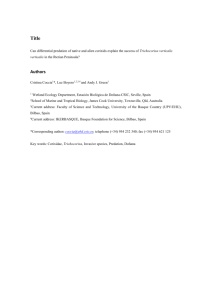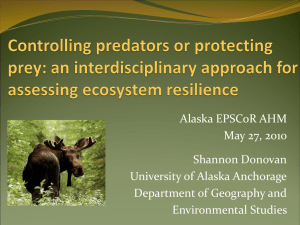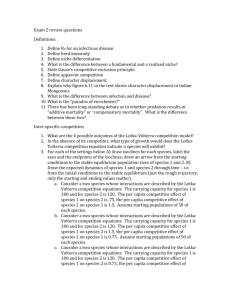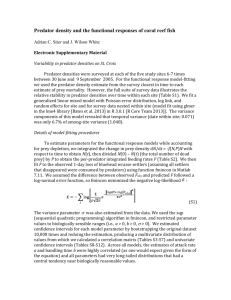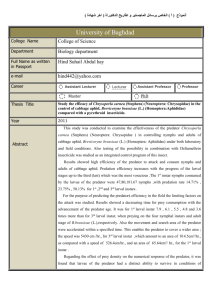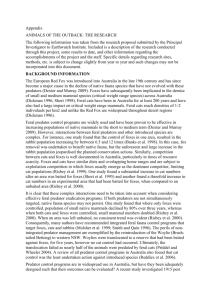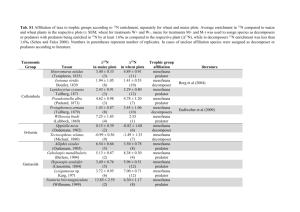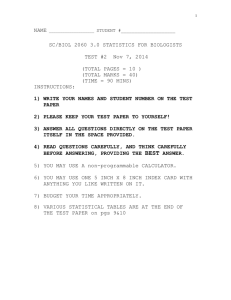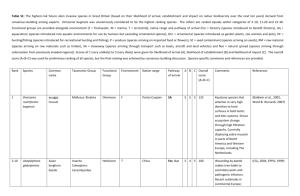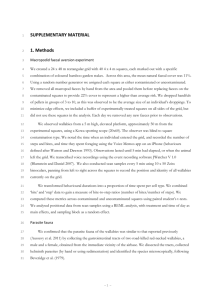School of Electrical and Electronic Engineering
advertisement
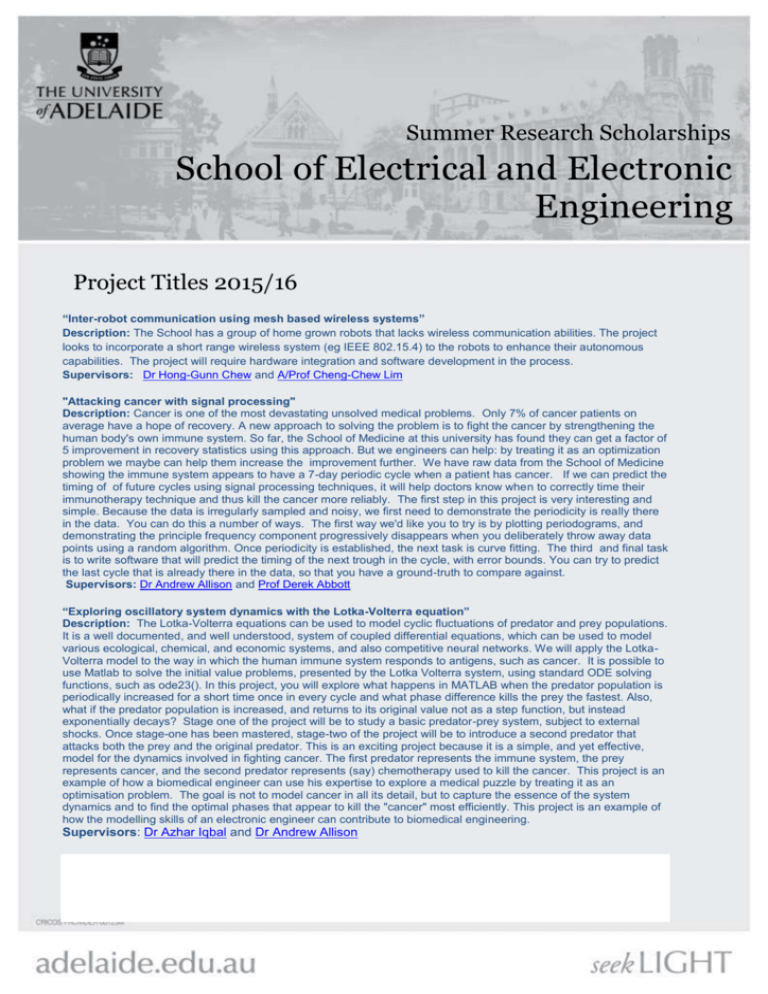
Summer Research Scholarships School of Electrical and Electronic Engineering Project Titles 2015/16 “Inter-robot communication using mesh based wireless systems” Description: The School has a group of home grown robots that lacks wireless communication abilities. The project looks to incorporate a short range wireless system (eg IEEE 802.15.4) to the robots to enhance their autonomous capabilities. The project will require hardware integration and software development in the process. Supervisors: Dr Hong-Gunn Chew and A/Prof Cheng-Chew Lim "Attacking cancer with signal processing" Description: Cancer is one of the most devastating unsolved medical problems. Only 7% of cancer patients on average have a hope of recovery. A new approach to solving the problem is to fight the cancer by strengthening the human body's own immune system. So far, the School of Medicine at this university has found they can get a factor of 5 improvement in recovery statistics using this approach. But we engineers can help: by treating it as an optimization problem we maybe can help them increase the improvement further. We have raw data from the School of Medicine showing the immune system appears to have a 7-day periodic cycle when a patient has cancer. If we can predict the timing of of future cycles using signal processing techniques, it will help doctors know when to correctly time their immunotherapy technique and thus kill the cancer more reliably. The first step in this project is very interesting and simple. Because the data is irregularly sampled and noisy, we first need to demonstrate the periodicity is really there in the data. You can do this a number of ways. The first way we'd like you to try is by plotting periodograms, and demonstrating the principle frequency component progressively disappears when you deliberately throw away data points using a random algorithm. Once periodicity is established, the next task is curve fitting. The third and final task is to write software that will predict the timing of the next trough in the cycle, with error bounds. You can try to predict the last cycle that is already there in the data, so that you have a ground-truth to compare against. Supervisors: Dr Andrew Allison and Prof Derek Abbott “Exploring oscillatory system dynamics with the Lotka-Volterra equation” Description: The Lotka-Volterra equations can be used to model cyclic fluctuations of predator and prey populations. It is a well documented, and well understood, system of coupled differential equations, which can be used to model various ecological, chemical, and economic systems, and also competitive neural networks. We will apply the LotkaVolterra model to the way in which the human immune system responds to antigens, such as cancer. It is possible to use Matlab to solve the initial value problems, presented by the Lotka Volterra system, using standard ODE solving functions, such as ode23(). In this project, you will explore what happens in MATLAB when the predator population is periodically increased for a short time once in every cycle and what phase difference kills the prey the fastest. Also, what if the predator population is increased, and returns to its original value not as a step function, but instead exponentially decays? Stage one of the project will be to study a basic predator-prey system, subject to external shocks. Once stage-one has been mastered, stage-two of the project will be to introduce a second predator that attacks both the prey and the original predator. This is an exciting project because it is a simple, and yet effective, model for the dynamics involved in fighting cancer. The first predator represents the immune system, the prey represents cancer, and the second predator represents (say) chemotherapy used to kill the cancer. This project is an example of how a biomedical engineer can use his expertise to explore a medical puzzle by treating it as an optimisation problem. The goal is not to model cancer in all its detail, but to capture the essence of the system dynamics and to find the optimal phases that appear to kill the "cancer" most efficiently. This project is an example of how the modelling skills of an electronic engineer can contribute to biomedical engineering. Supervisors: Dr Azhar Iqbal and Dr Andrew Allison “Development of an axon stretching device for traumatic spinal injuries repair” Description: This is a joint collaboration between School of EEE, Mechanical Engineering and Medical School. The aim is to build a bioreactor chamber that can be used to stretch axon. The original concept was developed by Loverde et al and demonstrated that axon can be stretched to 10-12 mm after 4 days of stretching. They achieved this by starting with a culture cells then stretching them in steps of a few micrometres every minute. This project will build on the current technique reported by Loverde et al (http://www.jove.com/video/2753/axon-stretch-growth-the-mechanotransduction-ofneuronal-growth) and build a new chamber that demonstrates that both ends of an axon (proximal and distal) can be stretched. Supervisors: Dr Said Al-Sarawi, Mr Ian Linke and Mr Malcolm Brinn “Fall predication and detection device for elderly people” Description: With this project you will join a group of leading researchers from academia and industry working toward the design of an ultra-low power, passive wireless sensors that present significant technical challenges and raise opportunities for innovative solutions. This is a multidisciplinary project and can accommodate students from mechanical engineering, electrical and electronic engineering and computer science disciplines. In case of mechanical engineering, the interest will be the design of miniaturised sensors such as accelerometers or gyro that can be integrated with electronic circuitry using microelectromechanical systems (MEMS), for the electrical and electronic engineering students the focus microelectronic side and integration off the shelf sensors with high performance microcontroller devices, while for computer science the focus is on the review and development of algorithms to predict and detect a fall. Supervisors: Dr Said Al-Sarawi and Dr Damith Ranasinghe “Transcription software that can support multiple unknown speakers simultaneously” Description: The project will build on current research activity between the School of Electrical and Electronic Engineering and the Defence Science and Technology Group (DSTG) in the area of automatic speech transcription. The aim of this project is to use a software component that was developed by the DSTG to facilitate transcription of multi-speaker simultaneously. The software, Multi-Profile Parallel Transcriber, uses Dragon NaturallySpeaking (DNS) speaker-dependent commercial speech recogniser as its engine. The software uses a computer network configuration that involves the use of virtual machines (VMware) to facilitate its multi-speaker support. So the aims are: (i) to recreate this environment and preform the needed software operation, (ii) modify the source code (written in Delphi programming language) to allow it to use the latest functions available from Dragon NaturallySpeaking (DNS) version 13, (iii) evaluate the software within the implemented network environment. Currently all of the software and hardware needed for this project are available for direct use. This project is suitable for a student with background in computer a network or computer system who has a passion for learning new software engineering and programming. Supervisors: Dr Said Al-Sarawi and Dr Ahmad Hashemi-Sakhtsari “Spin a yarn: investigating silk fibre nanostructures” Description: This interdisciplinary project intertwines engineering, physics, and biochemistry to study silk—a fascinating natural material that is strong yet elastic. The project involves extensive hands-on work to make silk fibres and to study their structures using far-infrared radiation. The use of assorted optical and chemistry-related laboratory equipment in and around campus will be required. If you like experimental work, then this is a unique opportunity for you to gain valuable skills that will allow you to “spin your own yarn” to your friends about your summer work experience. Supervisors: Dr Gretel Png and Dr Diana Tran "Understanding the battery characteristics and modelling for grid scale energy storage systems" Description: Large-scale battery-based energy storage systems are becoming significant part of both the power grid and standalone applications. In addition, energy storage technology will become the primary component in intermittent energy sources (wind and solar) to offer predictability and also to increase power system inertia, which is the lowest in South Australia. However understanding the operational characteristics of potential battery technologies are vital to study the system performance of such applications. This project will develop a test setup to measure and obtain potential battery characteristics under realistic charging and discharging conditions and investigate suitable models that can be used in system analysis. The result of this project will also provide valuable input to the University's recently awarded energy storage project. The students with design, measurement and analysis skills and specific interests in renewable energy areas and relevant industries are encouraged to apply. Supervisor: A/Prof Nesimi Ertugrul The University of Adelaide 2 The University of Adelaide 3



